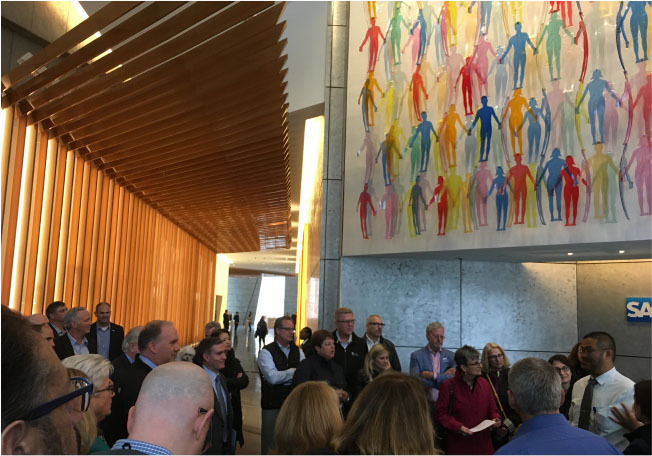 Hudson Yards is already redefining the west side of Manhattan
Hudson Yards is already redefining the west side of Manhattan
BOMA’s National Advisory Council (NAC) selected New York City as the location for its May event for two reasons: Hudson Yards and the World Trade Center (WTC), two of the most well-known real estate developments in North America. Both were featured on the agenda for the NAC meeting, which drew more than 60 commercial real estate executives from the United States and Canada. The event also included presentations by futurist Amy Webb and economist K.C. Conway and a case study of another iconic New York City asset, the Empire State Building.
Hudson Yards, the $25 billion project on Manhattan’s west side, is the largest private real estate development in the United States and includes office towers, luxury apartments and high-end retail stores. NAC members were treated to a private tour organized by the project’s developer, Related Companies.∗ The tour included Hudson Yards’ cogeneration power plant, designed to reduce energy costs and improve resiliency, and a 100-story trip up to the yet-to-be-completed Observation Deck. When completed, it will be the highest outdoor observation deck in the Western Hemisphere. The group ended the tour with a climb on the "Vessel," a huge spiral-staircase art structure with 154 flights of stairs and 80 landings.
A discussion of the WTC’s new normal in security, post-9/11, featured WTC Deputy Director Jim Kleeman, BOMA Fellow, RPA, along with his directors of Security and Fire/Life Safety, George Anderson and John Farrell. They described a comprehensive and multilayered approach to physical and vehicular security and screening, in partnership with police, Homeland Security and other community organizations, utilizing the latest technology. Patrolling security at the center is no mean feat, as the presenters explained. The WTC complex is 16 acres, with 250,000 daily commuters, five million annual visitors to the memorial, 50,000 office workers, 2.3 million annual observation deck visitors and massive office space.
Futurist Amy Webb led a conversation about new technologies impacting commercial real estate and the "uncertainties" and "disruptors" challenging our businesses and lives. According to Webb, political "insanity," climate instability, technology, regulatory shifts, China and a global economic slowdown are the uncertainties we face in 2019, combined with such disruptors as wealth distribution, infrastructure, education, government and healthcare.
 Hudson Yards' cogen power plant has been designed to reduce energy costs and improve resiliency.
Hudson Yards' cogen power plant has been designed to reduce energy costs and improve resiliency.
Companies will succeed by confronting these uncertainties and embracing and utilizing change to help us live and work better, what Webb referred to as "optimistic framing," as opposed to "catastrophic framing" that describes a world where we cede our personal privacy and decisions to Apple, Amazon and Google with potentially negative consequences. Unfortunately, she sees us heading toward the latter with 70 percent certainty and believes the U.S. government can play a role in influencing a different outcome. Webb also was the keynote speaker for the 2019 BOMA International Conference & Expo in Salt Lake City.
 NAC members in attendance were treated to two eye-catching artworks, both part of the Hudson Yards' contemporary art program: "Vessel," a massive, "interactive" art centerpiece...
NAC members in attendance were treated to two eye-catching artworks, both part of the Hudson Yards' contemporary art program: "Vessel," a massive, "interactive" art centerpiece...
Economist K.C. Conway, MAI, CRE, who is director of research and client engagement with the University of Alabama, described a positive "vroom" economy, with gross domestic product (GDP), jobs, corporate earnings, business formations and consumer spending all up. This despite such issues as rising construction costs in the wake of devastating hurricane damage and shortages in materials and labor. E-commerce continues to drive industrial market growth, he said, with Amazon leading the pack (noting 40 percent of everything we buy online is through Amazon). So, while things are looking good, Fed rate hikes or balance sheet reductions; a failure to pass the new North American Free Trade Agreement (NAFTA), which would be disastrous for the auto industry; a reduction in business and consumer confidence; additional catastrophic weather events; new lease accounting rules; and additional increases in construction costs could throw a wrench into this otherwise rosy economic picture.
 ...and a 30-foot-long sculpture of 390 interlocking figures
...and a 30-foot-long sculpture of 390 interlocking figures
The event closed with case studies that included the Empire State Building’s recent energy retrofit. JLL’s Dana Schneider, who managed the project, shared how the Empire State Building earned the distinction of being the most energy-efficient building in New York City. Energy use has been reduced by 38 percent, with annual savings of $4.4 million and a 3.1-year payback on energy retrofit investments.
BOMA’s National Advisory Council is led by Chair Shelby Christensen, senior vice president of Real Estate Operations at Liberty Property Trust, and Vice Chair Melanie Colbert, principal of Operations at LBA Realty. The group’s next meeting is October 9-11 in Carlsbad, California.
For more information on NAC, contact BOMA International’s Senior Vice President Patricia Areno or President and COO Henry Chamberlain.
∗BOMA wishes to thank Fred Knapp, executive director, and Roody Jean-Baptiste, operations manager, both with Related Companies, for hosting NAC’s tour of Hudson Yards.
This article was originally published in the July/August 2019 issue of BOMA Magazine.